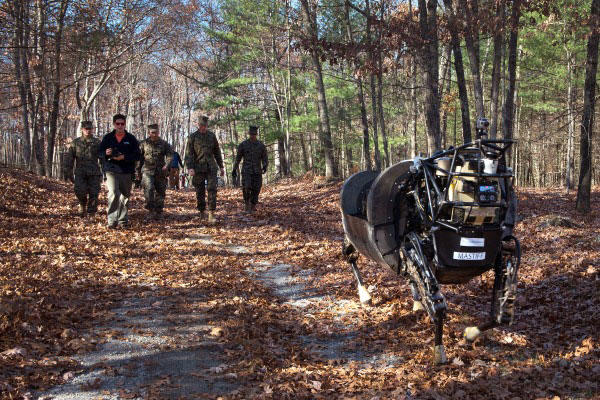After years of being featured at trade shows and trotted out for high-ranking Marine Corps officials, the Marines' barrel-chested Legged Squad Support System -- known affectionately as the robotic mule -- has been put out to pasture.
The machine, which resembles a headless pack mule made of metal, came about through a $32 million, two-and-a-half year contract between the Pentagon's research arm, known as the Defense Advanced Research Projects Agency, and Google Inc.'s Boston Dynamics, of Waltham, Massachusetts.
DARPA teamed up with the Marine Corps Warfighting Lab to create an autonomous four-legged creature that could lighten troops' load by carrying 400 or more pounds of weight, according to reports about the 2010 contract.
A second contract worth almost $10 million was awarded in 2013 for an additional phase of the LS3 program that would demonstrate how the legged robot would work by following troops on foot through rugged terrain, carrying their gear, and interpreting verbal and visual commands. The contract also provided for the construction of an enhanced version of LS3 that featured a quieter power supply and better survivability against small arms fire.
In 2012, Marine Corps Commandant Gen. James Amos attended a demonstration of the prototype's capabilities at Joint Base Myer-Henderson Hall, Virginia. At the time, Amos expressed pride in the developing technology and said it was getting close to something the Marines might use, according to reports.
The robo-mule had its big moment in summer 2014 at Rim of the Pacific, the largest military exercise in the Pacific region. It was featured in high-profile field tests with Marines who put it through its paces on patrols and demonstrated its ability to respond to commands and cross rugged ground.
But the experiment also exhibited the shortcomings of the prototype, Kyle Olson, a spokesman for the Warfighting Lab, told Military.com.
"As Marines were using it, there was the challenge of seeing the potential possibility because of the limitations of the robot itself," Olson said. "They took it as it was: a loud robot that's going to give away their position."
In addition to the lawnmower-like noise of the mule's gas-powered engine, there were other challenges without clear solutions, including how to repair the hulking robot if it breaks and how to integrate it into a traditional Marine patrol.
With the final funds remaining in the second Boston Dynamics contract, the DARPA-Warfighting Lab team built "Spot," a robotic quadruped the size of a large dog that functioned on quieter electric power. Last September, Marines put the smaller robot to the test in the woods of Quantico, Virginia.
But while Spot eliminated the noise problem, its slighter frame could only carry loads of 40 pounds or so and didn't display the advanced autonomous technology that LS3 had.
"I see Spot right now as more of a ground reconnaissance asset," said Capt. James Pineiro, the Ground Combat Element branch head for the Warfighting Lab. "The problem is, Spot in its current configuration doesn't have the autonomy to do that. It has the ability to walk in its environment, but it's completely controller-driven."
For now, both Spot and LS3 are in storage, with no future experiments or upgrades planned. Pineiro said it would take a new contract and some new interest from Marine Corps top brass to resurrect the program.
While it may seem as though years of work with the robot quadrupeds has wrapped up without a tangible result, Warfighting Lab officials said the Marine Corps did gain important insights about autonomous technology and its potential.
"We tend to play with things that are fanciful and strange," Olson said. "Learning from it was a big part, and we're still learning."
Meanwhile, the lab has ongoing experiments featuring drones and other unmanned vehicles and are exploring uses for them including medical resupply and reconnaissance.
-- Hope Hodge Seck can be reached at hope.seck@military.com. Follow her on Twitter at @HopeSeck.
Related Video:





























